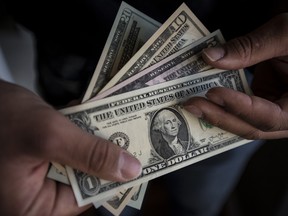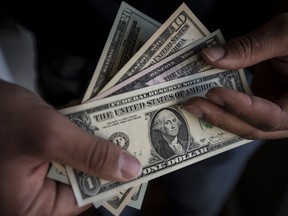
Martin Pelletier: Investors can protect themselves by owning more U.S. dollars

Article content
Talk about a convoluted market environment as we head into the last quarter of the year: long-dated United States Treasuries have now fallen 10 per cent this year and are now at their February 2011 lows; the equal-weighted S&P 500 is flat, while the Magnificent 7 are up more than 80 per cent; and the S&P/TSX composite is flat, but would have fared worse if not for an energy sector that is up nearly 20 per cent.
Advertisement 2
Article content
There are a couple of major trends that could play out over the next few months that will be important for investors to keep an eye on. The most important being a continued rise in the U.S. dollar against major currencies, with most of the downside in the euro and Canadian dollar. This is due to the U.S. economy’s strength and because it has less sensitivity to higher rates than other countries, especially Europe and Canada.
Article content
Article content
Despite the U.S. Federal Reserve no longer forecasting a recession, the government continues to run a deficit at 2008 financial crisis levels, which is extremely inflationary in nature. The deficit is so large that it equals eight per cent of gross domestic product, which is double the historical average of four per cent.
As a result, we’ve read that more than US$1.9 trillion of U.S. Treasury bonds are being issued over two quarters while countries such as China, Japan and Saudi Arabia are reducing their exposure.
The other factor driving inflation and supporting higher-for-longer rates in the U.S. is wage pressure. American workers are striking at a pace not seen in nearly a quarter-century. Large stoppages from strikes resulted in 4.1 million missed days of work in August, the biggest monthly total since August 2000, according to the U.S. Labor Department. At the same time, states such as California are increasing the minimum wage to $20 per hour.
Article content
Advertisement 3
Article content
The Fed has now hiked rates by 525 basis points since March 2022, sending mortgage rates to 7.25 per cent. However, the majority of Americans locked in ultra-low rates for 30 years during the great COVID-19 refinancing boom, so higher mortgage rates aren’t having much of an impact. The U.S. housing market has risen for five consecutive months and is up 5.2 per cent this year.
The same situation is playing out in corporate America with net interest payments actually declining this year as many companies locked in low interest rates on their debt in 2020 and 2021 and they are now earning much higher yields on their cash.
In Europe, countries such as France have announced they are aiming to eliminate all fossil fuels by 2030. We think this will remove a critical inflation hedge, sending many European economies into a recession and leaving the European Central Bank in a tough position, forcing them to lower rates, which will reduce their currency value against the U.S. dollar.
Canada, meanwhile, has a significant exposure to interest rates given that a whopping 40 per cent of its total gross fixed-capital formation over the past five years has gone into real estate, by far the highest in the G7. On a per-capita basis, many of our provinces rank in the lowest quartile of labour productivity when compared to the 52 states.
Advertisement 4
Article content
It isn’t a coincidence that Alberta is the top-performing province and is neck and neck with Texas. Yet the federal government is intent on deploying the same tactics as France in phasing out oil and gas, and the economic growth that comes with it.
Putting it all together, the Bank of Canada could be forced to cut rates next year or risk sending the economy into a deeper recession since home prices haven’t budged much (thanks to record-setting immigration) despite much higher debt-servicing costs. This means the bottom could fall out of our currency as the Fed holds pat. If this happens, it wouldn’t be surprising to see the loonie at 70 cents U.S. or lower.
Fortunately, there are a few things investors can do to protect themselves, and owning more U.S. dollars is a good place to start. Despite energy posting some healthy gains again this year, Canadian producers still offer an excellent hedge given their revenue stream is in U.S. dollars and their cost structure is in Canadian dollars. Their cash-flow’s exposure is at the highest levels we’ve ever seen and that’s paired with balance sheets that are in excellent shape.
Advertisement 5
Article content
Recommended from Editorial
We’re also trimming our S&P 500 exposure due to the concentration risk in the Magnificent 7, which we think will sell off as the Fed delays pivoting. We are redeploying these funds into U.S. high rate money market, U.S. floating rate bonds and U.S.-denominated structured notes. Finally, we maintain the lowest exposure to European equities we’ve ever had because of their continued push to strangle their own economy via an all-or-nothing energy policy.
Managing currency and duration exposure may not seem that exciting or magnificent, but it could prove especially helpful in the months to come.
Martin Pelletier, CFA, is a senior portfolio manager at Wellington-Altus Private Counsel Inc, operating as TriVest Wealth Counsel, a private client and institutional investment firm specializing in discretionary risk-managed portfolios, investment audit/oversight and advanced tax, estate and wealth planning.
_____________________________________________________________
If you like this story, sign up for the FP Investor Newsletter.
_____________________________________________________________
Article content





